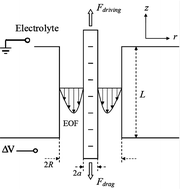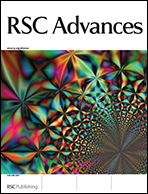Prediction of the effective force on DNA in a nanopore based on density functional theory†
Abstract
Voltage-driving DNA translocation through a nanopore is considered in the present study. By assuming the DNA is coaxial with the cylindrical nanopore, a hydrodynamic model for determining effective force on a single DNA molecule in a nanopore is presented, in which density functional theory (DFT) combined with the continuum Navier–Stokes (NS) equations is utilized to investigate electro-osmotic flow and the viscous drag force acting on the DNA inside a nanopore. Surface charge on the walls of the nanopore is also taken into account in our model. The consistence between our calculation and the previous experimental measurement indicates that the present theoretical model is an effective tool to predict the hydrodynamic resistance on DNA. Results show that charge inversion, which cannot be obtained by the Poisson–Boltzmann (PB) model, will reduce electro-osmotic velocity, or even lead to flow reversal for high salt concentration. This is helpful to raise the effective force profoundly in the overscreening region.


 Please wait while we load your content...
Please wait while we load your content...